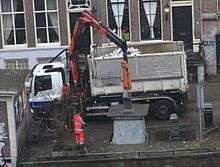Recycling in the Netherlands
Recycling in the Netherlands is under the responsibility of local authorities.[1][2] Different localities implement different systems. Municipalities all over the country publish a calendar, on a yearly basis, of the pickup dates and the addresses of the waste separation and recycling stations.[3]
Collection processes

The curbside collection systems for recyclates employed vary across the Netherlands:
- Biodegradable waste, "GFT" ("Groente-, Fruit-, en Tuinafval") box or Green bin - almost all municipalities except some quarters of major cities.
- Paper collection, Blue bin - almost all municipalities and in most major cities in large containers on street corners.
- Plastics, Yellow bin in some municipalities and in most major cities in large containers on street corners.
- Household chemicals, batteries, TL, etc., Red bin - most cities.
- Clothing, Green clothing containers - most cities.
Municipality Recycling facilities
All municipalities are required to provide known collection points for recyclable and/or hazardous materials. All types of separated trash can be accepted here for free or a small sum depending on type of material (green stuff and concrete/bricks is usually free). Some stores perform collection of chemicals (paint, batteries). There are a great number of second-hand shops (run by charity organisations) that accept goods for processing, which consists of re-use, recycling and burning it as fuel.
Facts and figures
Landfills are used for less than 10% of all waste. Dutch household waste recycling averages 49% (2012). [4]
- Compost (2003):
The separately gathered organic fraction is 50% of household waste, or 1500 kilotonnes. This is processed to 600 kilotonnes of compost, and the end-product partially exported while over annual national consumption.
- Paper (2005):
In the Netherlands itself, the recycled amount in 2005 was up to 2.5 million tonnes, which is 75% of annual consumption. By contrast, in the EU, over 50% of paper is recycled. The Dutch government wants 75% of household waste to be separated by 2020, which means that waste will decrease from 250 kilograms per capita per year to 100 kilograms per capita per year in 2020 [5].
Recycling expertise
The Dutch have a lot of experience in recycling, stimulated by lack of free grounds and significant government funding. This expertise is sensibly exported. A 2006 article reports Dutch involvement in reform of recycling in the UK.[6]
EU Regulations
National law concerning recycling is heavily influenced by EU regulations. Reforms may have great impact on national collection systems (for instance a downgrade of the recycling system is imaginable, when deposits on types of drink containers are lifted). Also, the environmental impact of industry is closely guarded by EU standards.
Deposit systems
Deposit systems are in use for beer bottles, larger plastic bottles, and plastic crates for bottles. For these items, the deposit (or statiegeld) is returned by automated machines at supermarkets. A video of such a machine in use and returning the deposit is available on YouTube.[7]
Gas bottles and household appliances are also covered by this (Although for these the money is never returned, it requires a shop owner to accept the discarded item it replaces, if handed in. The used term is "verwijderingsbijdrage" or "removal fee". Extra earnings from this system are spent on investments in the recycling industry).
Materials collected
The different types of recyclable materials collected include:
- All types of paper/paperboard (excluding plastics, metal fragments and organic contamination)
- Glass jars and bottles - by common collection points
- Compostable materials
- Plastics - Type 1 and 2 PETE
- Motor oil
- Tires - some re-treaded, some mixed with asphalt for road resurfacing
- Metal cans - beverage and soup cans, although usually extracted from trash by separation techniques
- Beer bottles through deposit systems
- Plastic soda containers through deposit systems
- Ink cartridge
- All types of batteries
- Clothing and toys for second-hand use
- Construction timber
- Concrete and bricks used as roadfill, or ground down and mixed as new
- Household appliances - may also be returned through shop when buying new products
References
- Ferrara, Ida; Missios, Paul (1 November 2012). "A Cross-Country Study of Household Waste Prevention and Recycling: Assessing the Effectiveness of Policy Instruments". Land Economics. 88 (4): 710–744. doi:10.3368/le.88.4.710. ISSN 0023-7639.
- Goorhuis, Maarten; Reus, Pieter; Nieuwenhuis, Ellen; Spanbroek, Natascha; Sol, Mario; van Rijn, Jørgen (September 2012). "New developments in waste management in the Netherlands". Waste Management & Research. 30 (9_suppl): 67–77. doi:10.1177/0734242X12455089.
- https://www.angloinfo.com/how-to/netherlands/housing/setting-up-home/recycling
- http://www.eea.europa.eu/data-and-maps/daviz/municipal-waste-recycled-and-composted
- Milieubeheer, Ministerie van Volkshuisvesting, Ruimtelijke Ordening en. "Huishoudelijk afval scheiden en recyclen". www.rijksoverheid.nl (in Dutch). Retrieved 2018-02-20.
- "Archived copy". Archived from the original on 2013-02-22. Retrieved 2007-06-11.CS1 maint: archived copy as title (link)
- "Robotic Dutch bottle re-use machine", Youtube. Accessed: August 18, 2012.
